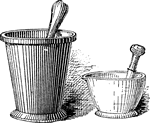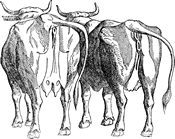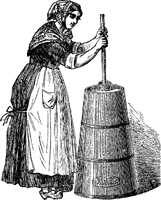Food for Thought
A collection of food news and trivia from around the world.
Real food
 “If you use honest to goodness ingredients, you will end up with a superior product. There’s a reason why industrial food lasts forever: it has to. It has to have a shelf life (the only life it actually has), and survive being transported in all temperatures and conditions. Finally, don’t ever think industrial food will use even “good” ingredients. There’s a thing called the Triple Bottom Line: where it’s good for the economy, for the farmer/producer, and good for the community. That’s not in their definition of what’s good for the Single Bottom Line: profit.”
“If you use honest to goodness ingredients, you will end up with a superior product. There’s a reason why industrial food lasts forever: it has to. It has to have a shelf life (the only life it actually has), and survive being transported in all temperatures and conditions. Finally, don’t ever think industrial food will use even “good” ingredients. There’s a thing called the Triple Bottom Line: where it’s good for the economy, for the farmer/producer, and good for the community. That’s not in their definition of what’s good for the Single Bottom Line: profit.”
From an article on making doughnuts in Mother Earth News by Sue Van Slooten. June 2013. motherearthnews.com
Cream of the crop
“I just want to ask us all to reflect a little bit on our experiences of local food. If I think about a time before it was conscious to me that I was eating local food or not, I can remember being really very excited in the summer when August would come, because that was the time when we could get corn. We could get Ontario-grown corn. We would go to pick up – or my dad would pick up on the way home from his office –local corn at Mr. Topper’s farm in Richmond Hill. That was his name, and he was just north of Elgin Mills. We only ate corn in August. We didn’t eat corn any other time of the year. I don’t even know if it was available in stores, but certainly my father had a complete prejudice about Ontario corn: that it was the best-tasting corn, and that’s the only corn we should eat.”
Hon. Kathleen Wynne speaking in the Ontario Legislature April 9, 2013.
The poop on manure
 “Fertilizing crops with cattle manure can lead to better soil quality than when synthetic fertilizer is used, recent research indicates. The use of cattle manure in the study led to greater soil fertility by encouraging higher microbial activity, and the researchers suggest that it could potentially improve soil’s ability to cope with periods of difficult growing conditions.”
“Fertilizing crops with cattle manure can lead to better soil quality than when synthetic fertilizer is used, recent research indicates. The use of cattle manure in the study led to greater soil fertility by encouraging higher microbial activity, and the researchers suggest that it could potentially improve soil’s ability to cope with periods of difficult growing conditions.”
From Science for Environmental Policy, June 2013. europa.eu
Far and wide
“The average food item in Toronto travels 4,500 km from field to table. That has a huge impact on our environment. They say a third of greenhouse gases and pollution are connected to the way we move food from field to table. When in every province in the country there’s an explosion of diet-related illness: diabetes, cancer, heart disease, obesity. That’s what you get, all of those things, when you treat food as a pure commodity.”
From an interview with Nick Saul of The Stop published in The Hill Times. May 2013.
No bees, no peas
 “According to Whole Foods: ‘One of every three bites of food comes from plants pollinated by honeybees and other pollinators. Yet, major declines in bee populations threaten the availability of many fresh ingredients consumers rely
on for their dinner tables.
“According to Whole Foods: ‘One of every three bites of food comes from plants pollinated by honeybees and other pollinators. Yet, major declines in bee populations threaten the availability of many fresh ingredients consumers rely
on for their dinner tables.
‘To raise awareness of just how crucial pollinators are to our food system, the University Heights Whole Foods Market store [Toronto] temporarily removed all produce that comes from plants dependent on pollinators. They pulled from shelves 237 of 453 products – 52 per cent of the department’s normal product mix.’
Freaky, right? At least we’ll still have chili-cheese Fritos.”
From an article by Holly Richmond at grist.org. June 2013.
The feminization of farming
 “‘Sharing power with women is a shortcut to reducing hunger and malnutrition, and is the single most effective step to realizing the right to food,’ said the United Nations special rapporteur on the right to food, Olivier De Schutter, while urging world governments to adopt transformative food security strategies that address cultural constraints and redistribute roles between women and men.
“‘Sharing power with women is a shortcut to reducing hunger and malnutrition, and is the single most effective step to realizing the right to food,’ said the United Nations special rapporteur on the right to food, Olivier De Schutter, while urging world governments to adopt transformative food security strategies that address cultural constraints and redistribute roles between women and men.
‘Family agriculture has become gradu-ally feminized, with men frequently moving away from the farm in search of work. Yet the women, who increasingly face the burden of sustaining farms and families, are too often denied the tools to thrive and improve their situation – on and off the farm.’”
From a report on Gender and the Right to Food presented to the UN Human Rights Council in Geneva. March 2013.
Everything’s better with butter
“Everybody dies, there’s no avoiding it and I do not believe for one second that butter is the cause of anyone’s death. Overeating maybe, but not butter, please.”
Norah Ephron in Newsweek. August 2009.
Can’t stand the heat
 “The oven is one of the most energy-intensive appliances in your home so use it mindfully. When you turn it on, cook more than one dish to maximize the heat. And try not to use it too often.”
“The oven is one of the most energy-intensive appliances in your home so use it mindfully. When you turn it on, cook more than one dish to maximize the heat. And try not to use it too often.”
Sarah Elton interviewed for Fiesta Farms. April 2013.
Local food aid
“The food aid reform act … would eliminate previous requirements that food assistance be grown in the U.S. and transported on U.S.-flagged ships. Advocates say the changes would deliver aid up to 14 weeks faster and reach an estimated two to four million more people…
“‘You have to order the food in the midwest, it gets put on a ship, it can go 7,000 miles to the other side of the world, put onto trucks, and then moved into the famine or emergency zone,’ Andrew Natsios, a professor at Texas A&M University, testified. ‘If the food is bought locally, you avoid the 7,000-mile food chain.’”
From The Guardian. June 2013
More than rarebit
“As a visitor to the principality, I have been taken aback by just how Welsh Welsh food, currently is. Compared to other parts of Britain, the ethos of modern British cooking, of using local Welsh produce in Welsh dishes, seems to have penetrated way beyond the obvious foodist venues. Some of this, the presence of cawl, faggots, Bara Brith and Welsh cakes on menus, is a matter of long-standing tradition, perhaps. But the near ubiquity of Perl Las cheese, Penlon and Tomos Watkin beers, the emphasis on Welsh beef and lamb on menus, seems like a newer phenomenon – as if food is part of what, for the past two decades, has been a wider (soft, cultural) resurgence in Welsh national pride. Food, it seems, is just another way that the Welsh assert their national identity.”
From Word of Mouth food blog by Tony Naylor. theguardian.co.uk






